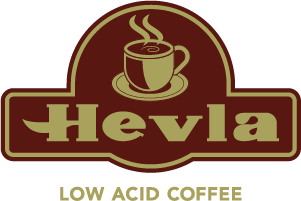Coffee Acidity
Coffee in its inherent state is acidic in nature. The apparent sharpness of coffee is relative to the proton interaction of acids present in the coffee to the taste bud receptors found on the human tongue. Acidity in coffee can be influenced by several factors such as the bean genus itself, the kind of minerals present in the soil used to grow the coffee as well as the altitude of the growing grounds. Preparation and roasting can also greatly affect the concentration of acidity in coffee. Majority of coffee is roasted and keeps its acidic nature; however, Hevla Coffee has an all natural steaming process that is specially formulated to remove more than 70 irritants that can be harmful to the body. Because of this steaming process that removes irritants, Hevla Coffee is considered low acid and thus is a healthier alternative to regular coffee.
There are also chemical agents that promote the onset of acidity in coffee based on the apparent chemical reactions that occur during the roasting process. Heat is a catalyst of acidity formation in coffee and depending on the roasting level, type of roasting machine and brewing method, a coffee can turn out with high acidity levels or the opposite. The acidity in coffee helps distinguish its flavor from other coffee brews. You might say that the acid components of coffee help give it its distinct signature. Acidic compounds found in coffee are generally classified into aliphatic acids, chlorogenic acids and phenolic acids.
This chart shows the main acids that have been reported in coffee:
|
Volatile Aliphatic Carboxylics
|
Non- Volatile Aliphatic Carboxylics
|
Chlorogenic |
Alicyclic/phenolic |
|
Formic |
Pyruvic |
3-monocaffeoylquinic acid |
Quinic |
|
Propanoic |
cis- and trans-but-e-enoic |
4-monocaffeoylquinic acid |
Ferulic |
|
Butanoic |
cis- and trans-2-methylbut- 2-enoic |
5-monocaffeoylquinic acid |
Caffeic |
|
Methylpropanoic |
3-methylbut-2-enoic |
3,4-dicaffeoylquinic acid |
|
|
Pentanoic |
methylpropenoic |
3,5-dicaffeoylquinic acid |
|
|
3-Methylbutanoic |
oxalic |
4,5-dicaffeoylquinic acid |
|
|
Hexanoic |
malonic |
|
|
|
Heptanoic |
succinic |
|
|
|
Octanoic |
3-methylene butanedioic |
|
|
|
Nonanoic |
glutaric |
|
|
|
Decanoic |
Malic |
|
|
|
|
tartaric |
|
|
|
|
cis- and trans-butenedioic |
|
|
|
|
cis- and trans-methylbutenedioic |
|
|
|
|
methylenebutanedioic |
|
|
|
|
citric |
|
|
|
|
propene- 1,2,3-tricarboxylic |
|
|
Aliphatic acids are generally found to comprise 1.5 % of overall coffee chemistry on a typical light roast while dark roasts which decrease the acidity of coffee lowers down the aliphatic acid content by almost 50%. Analyzing the acid components of coffee will show that malic, citric, acetic acid and lactic acid are found to be in the range of .30 to .07 % compositions in varying degrees. Chlorogenic acids however have been observed to have a higher concentration in coffee, comprising of as much as 7% of the base compound that make up regular coffee. Among the chlorogenic acids, 3-CQA which is subsequently the largest isomer identified takes up 5%. There are more than 17 chlorogenic acid derivatives found in various samples of coffee. Although there is an abundance of chlorogenic acid compounds in the innate state of coffee, most of it is broken down during the chemical reactions in the roasting process, creating quinic acid as a byproduct.
Heightened amounts of quinic acid buildup is one of the contributing factors identified to cause a disapproving sourness during a dark roast or if the preparation was left on too long and exposed to prolonged heat. Although there is a rise in sourness because of the process, the effects on the coffee’s pH level is opposing, generally reducing the acidity levels of the coffee chemistry. Clinical studies have also pointed out that the acidity of coffee can result from a correlation between heating temperature, particle solubility and extraction. The table shows a sample data depicting trial analysis on acid concentration at different solubility levels:
| Acids | Course Grind Size (mg/L) | Fine Grind (mg/L) | Extra Fine Grind (mg/L) |
| Lactic Acid | 109.67 | 194.5 | 308.33 |
| Acetic Acid | 242.67 | 225.67 | 209 |
| Citric Acid | 325 | 461 | 440 |
| Malic Acid | 119.33 | 137 | 163.67 |
| Phosphoric | 68.33 | 77.33 | 82 |
| Quinic Acid | 435.33 | 495 | 510 |
| Chlorogenic | 700 | 1,064.67 | 1,177.00 |
| Palmitic Acid | 5.03 | 5.9 | 3.63 |
| Linoleic Acid | 6.27 | 5.97 | 4.5 |
It has been observed that at elevated temperatures (generally at 220°C) the destruction of specific amino acids become imminent during the roasting process. Amino acids play an important role in the aromatization of coffee during the pre-phases of the roasting. Another observation made is that the amount of phosphoric acid found in coffee, in its insignificant quantities do not bear any direct correlation to the perceived acidity, and is merely a minor contributing element.
Hevla uses an all-natural steaming method in removing the acid content (70+ irritants are removed in our natural steaming process) in coffee beans and no chemicals are introduced in the process, thus preserving as much the original taste and aroma of the coffee.

